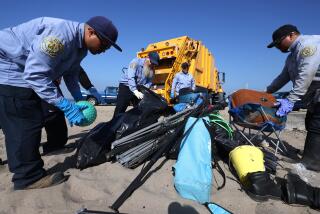Roosting spot for threatened birds gets a new fence at Dockweiler State Beach
In an effort to coax a small shorebird off the federal threatened species list, a historical roosting ground at Dockweiler State Beach in Playa del Rey has been fenced off to protect the birds from people and vehicles, authorities said.
The Western snowy plover has been steadily losing its nesting grounds to beachgoers over the last several decades, said Jane Hendron, a spokeswoman for the U.S. Fish and Wildlife Service in Carlsbad.
“Historically, we had Western snowy plovers nesting from Southern California up to Oregon, but as you can imagine, we have developed many hundreds and hundreds of miles of beaches,” Hendron said. “Their habitat was lost.”
The birds are federally listed as a threatened species, which means they are at risk of becoming endangered.
The enclosure just north of Imperial Highway is the result of a three-year effort by federal and county officials and the Los Angeles Audubon Society. The Fish and Wildlife Service is committed to spending up to $14,000 on the project, officials said. Passersby may now spot an orange mesh fence surrounding the enclosure, with one side open to the ocean. What they may not see, however, are the Western snowy plovers.
“You can look right at them and think you’re looking at sand,” said David De Lange, president of the Los Angeles Audubon Society, an experienced bird watcher.
Plovers nest in the dunes by scratching an indentation in the sand, sometimes under a piece of debris, and lay their sand-colored eggs inside. But the camouflage may also make them vulnerable to unwary foot traffic.
“The chicks look like little cotton balls on sticks. They are cute,” Hendron said. “But it’s very easy to miss them, and if people even let their dogs off the leash, the dogs can step on the eggs. They can kill a chick.”
That could be one reason the birds do not feel safe enough to nest at the Dockweiler site. The plovers will roost or hang out, but once the instinct to lay eggs kicks in, they tend to leave for safer areas, bird watchers say.
This has become a problem across Los Angeles County, De Lange said, noting that there has not been a confirmed Western snowy plover nesting on a county beach since 1949. Scientists hope that fencing off the area will discourage people from disturbing the birds, allowing them to relax enough to build nests. Experts have tried this approach at other sites in California, including Huntington Beach, with positive results, Hendron said.
“The hope is that these birds feel protected enough to breed and to fledge a chick,” said Garry George, conservation chairman for the L.A. Audubon Society, which plans to set up telescopes and start a docent program to teach beachgoers about the plovers.
Figures show local conservation efforts may be working. The U.S. population of the species in 1993, when it was first listed as threatened, numbered fewer than 1,400. By 2005, the official head count had grown to 2,300.
More to Read
Sign up for Essential California
The most important California stories and recommendations in your inbox every morning.
You may occasionally receive promotional content from the Los Angeles Times.









